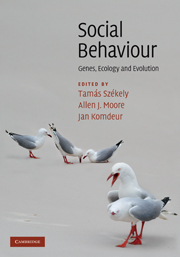Book contents
- Frontmatter
- Contents
- List of contributors
- Introduction: The uphill climb of sociobiology: towards a new synthesis
- Profile: Undiminished passion
- Part I Foundations
- 1 Nature–nurture interactions
- Profile: Social evolution, sexual intrigue and serendipity
- 2 The quantitative genetics of social behaviour
- Profile: Mating systems: integrating sexual conflict and ecology
- 3 Social behaviour and bird song from a neural and endocrine perspective
- Profile: In love with Ropalidia marginata: 34 years, and still going strong
- 4 Evolutionary game theory
- Profile: The huddler's dilemma: a cold shoulder or a warm inner glow
- 5 Recent advances in comparative methods
- Profile: Multi-component signals in ant communication
- 6 Social evolution theory: a review of methods and approaches
- Profile: What's wrong with this picture?
- Part II Themes
- Part III Implications
- Species index
- Subject index
- References
5 - Recent advances in comparative methods
Published online by Cambridge University Press: 05 June 2012
- Frontmatter
- Contents
- List of contributors
- Introduction: The uphill climb of sociobiology: towards a new synthesis
- Profile: Undiminished passion
- Part I Foundations
- 1 Nature–nurture interactions
- Profile: Social evolution, sexual intrigue and serendipity
- 2 The quantitative genetics of social behaviour
- Profile: Mating systems: integrating sexual conflict and ecology
- 3 Social behaviour and bird song from a neural and endocrine perspective
- Profile: In love with Ropalidia marginata: 34 years, and still going strong
- 4 Evolutionary game theory
- Profile: The huddler's dilemma: a cold shoulder or a warm inner glow
- 5 Recent advances in comparative methods
- Profile: Multi-component signals in ant communication
- 6 Social evolution theory: a review of methods and approaches
- Profile: What's wrong with this picture?
- Part II Themes
- Part III Implications
- Species index
- Subject index
- References
Summary
Overview
The comparative method is one of the oldest and most widely used approaches to studying evolution. The rationale is that a group of species contains more variation than can be created in an experiment or using observations on a single species, and comparisons across species can be used to test broad questions in evolutionary theory. One of the key issues in comparative analysis is the problem of phylogeny. Phylogeny can create problems through generating non-independence of data, which compromises statistical tests, but it also generates opportunity by allowing the evolution of traits to be mapped. The modern comparative method is based on modelling the evolutionary process, using models of trait evolution to generate statistical models that can fitted to trait data.
We review a range of the current models and techniques used in comparative analysis. We begin by looking at techniques for modelling continuous traits, concentrating on methods for measuring variation in the rate of evolution through time, speciational modes of evolution, constraints on traits and variable levels of phylogenetic dependence. We then look at issues of uncertainty in data and how this may be incorporated, including uncertainty resulting from phylogenetic error, measurement error and other forms of non-independence. Developments on the analysis of discrete traits are described, including the use of modern Bayesian model averaging and selection methods. Finally we describe how the links between macroevolution (speciation and extinction) and trait evolution can be uncovered.
- Type
- Chapter
- Information
- Social BehaviourGenes, Ecology and Evolution, pp. 110 - 126Publisher: Cambridge University PressPrint publication year: 2010
References
- 4
- Cited by

